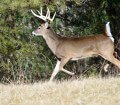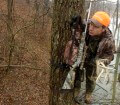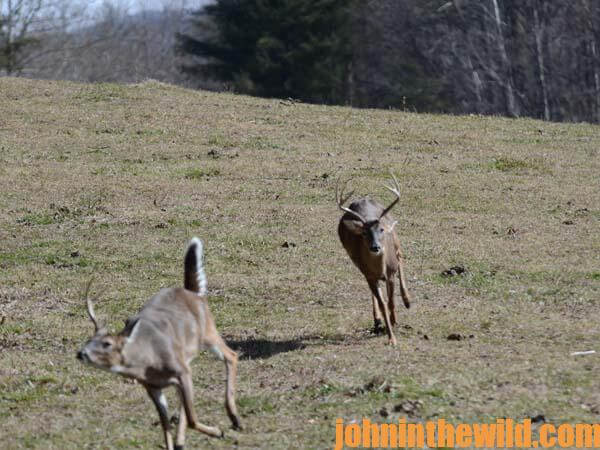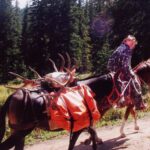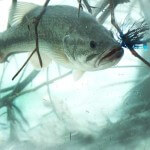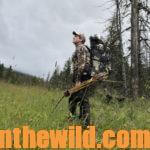John’s Note: Longtime, avid deer hunters Chris Yeoman, a guide, and Dr. Jim Nelson – both of Rapid City, South Dakota – enjoy shooting deer on the run and think nothing of making several hundred yard shots at running deer.
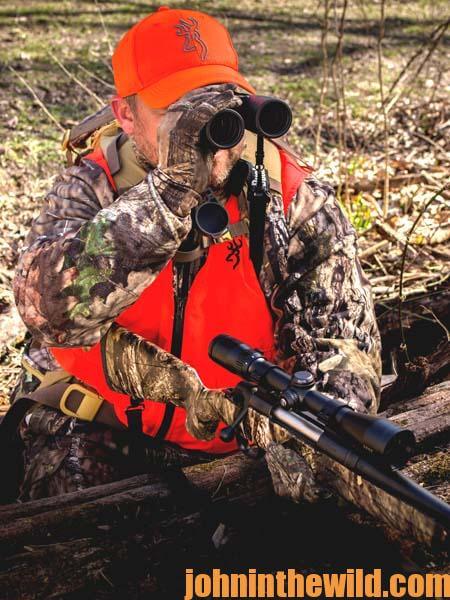 Just as important as the rifle and the bullet are to Yeoman and Nelson’s success, each man knows the riflescope he uses also plays a major role in his ability to shoot accurately over long distances at deer on the run. Both men prefer higher magnification when shooting deer at long ranges.
Just as important as the rifle and the bullet are to Yeoman and Nelson’s success, each man knows the riflescope he uses also plays a major role in his ability to shoot accurately over long distances at deer on the run. Both men prefer higher magnification when shooting deer at long ranges.
“I like the 4-12X Leupold scope,” Nelson says. “I use the 12X to judge the buck’s rack quickly at 200 to 300 yards. When you have a buck running away from you at that distance, you don’t have enough time to take your binoculars, study the buck, make a decision whether or not you should shoot, lower the binoculars, mount your rifle, find the deer in your scope and take the shot. By having the ability to zoom out to 12X, I can check out the rack. Then, if I need to back the scope down to hold steadier and shoot accurately, I can. But all these adjustments can be made quickly and easily by having this type of scope.”
Another advantage the 4-12X Leupold offers Nelson is that because he hunts the thick-cover areas, he also can set his scope on 4X. If he sees the buck in thick cover before it breaks to run, Nelson can make the shot quickly and easily at close range with the lesser power. Once the deer breaks from cover and begins to run away from Nelson, he can zoom the scope up and make long-distance running shots. Nelson can find running bucks in his scope even at long distances and even with the scope at 12X because he has spent the time required to set his eye relief properly.
“One of the reasons I like the Leupold scope is because you have far more eye relief – 2 to 4-1/2 inches – than you do with some other scopes,” Nelson explains. “Being able to rapidly find that deer in your scope is important when you’re shooting at long distances. I can look over the top of my scope and see the buck as he’s running away. Then, when I bring my cheek down to the stock, I can see the deer in my scope between the crosshairs. When some hunters look at deer running away from them over their scopes and look through their scopes, they can’t find the animal. Then they have to search for the buck and waste valuable aiming time. If I could make one suggestion to improve a hunter’s ability to take bucks on the run, it would be to make sure you first purchase a scope with good eye relief. Next get the scope mounted, so that when you look over the scope and bring your cheek down, you don’t lose track of the target.”
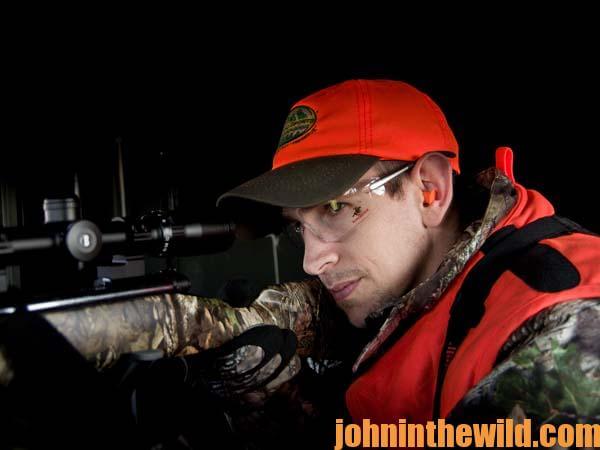 Another advantage to utilizing the 12X scope is when Nelson aims at a deer running away from him he has more animal in his scope to aim at, than if his scope is set on a lesser power. “With the scope set on 12X, at 100 to 200 yards I see just crosshairs and deer in the scope, and aiming is much easier and faster,” Nelson says. “If you’ve got the scope at a lesser power, you have more terrain and less deer at which to aim. The possibility of your shooting more accurately when you’ve got a buck on the run is better with a higher powered scope. Add to this factor a kneeling or a sitting position where your hold is more stable, and you double or triple your chances of shooting accurately.” In South Dakota, where Nelson primarily hunts, 200-yard-plus shots are common. He is convinced the larger-powered scopes play a major role in his shooting accuracy.
Another advantage to utilizing the 12X scope is when Nelson aims at a deer running away from him he has more animal in his scope to aim at, than if his scope is set on a lesser power. “With the scope set on 12X, at 100 to 200 yards I see just crosshairs and deer in the scope, and aiming is much easier and faster,” Nelson says. “If you’ve got the scope at a lesser power, you have more terrain and less deer at which to aim. The possibility of your shooting more accurately when you’ve got a buck on the run is better with a higher powered scope. Add to this factor a kneeling or a sitting position where your hold is more stable, and you double or triple your chances of shooting accurately.” In South Dakota, where Nelson primarily hunts, 200-yard-plus shots are common. He is convinced the larger-powered scopes play a major role in his shooting accuracy.
Why Most People Shouldn’t Attempt Long, Running Shots:
Yeoman has taken running deer at distances out to 500 yards. Both Yeoman and Nelson consistently bag deer on the run from 200 to 400 yards. “To be able to shoot accurately at great distances, you have to do a lot of shooting at moving targets,” Yeoman explains. “But just because you can shoot accurately at a moving target that’s further than 100 yards doesn’t mean you should take a shot at a running deer at that distance. Most hunters don’t have the right types of guns or the correct bullets to bag deer at that distance. I’ve seen hunters come to the West with 7mm Mags and hollow-point bullets and try to make one of those long-distance running shots. The problem is not in their ability to possibly hit the deer but rather what occurs if they do hit the deer. They’ll often get poor hits without proper penetration. Most likely they’ll wound animals that may get away.
 “When I shoot, I’m not simply attempting to hit the buck. I want to take him with a bullet placed in his vital organs that will bring him down quickly and efficiently. Usually that’s where my bullet will land. But Jim and I can shoot accurately because we’ve got the rifles, the scopes, the bullets and the experience to make those long-distance running shots. To regularly take bucks on the run, you’ve got to shoot a lot of ammunition at a large number of targets.”
“When I shoot, I’m not simply attempting to hit the buck. I want to take him with a bullet placed in his vital organs that will bring him down quickly and efficiently. Usually that’s where my bullet will land. But Jim and I can shoot accurately because we’ve got the rifles, the scopes, the bullets and the experience to make those long-distance running shots. To regularly take bucks on the run, you’ve got to shoot a lot of ammunition at a large number of targets.”
These two men’s long-range shooting skills at running deer have developed to where they now are automatic responses. Nelson and Yeoman don’t have to think how to aim and when to squeeze their triggers. Instead their brains automatically make these calculations. Their secrets to shooting big bucks on the run at great distances include using the right equipment, practicing shooting at smaller game and having years of experience.
To get John E. Phillips’ Kindle eBooks and print books on hunting deer, “How to Hunt and Take Big Buck Deer on Small Properties,” “How to Hunt Deer Up Close: With Bows, Rifles, Muzzleloaders and Crossbows,” “PhD Whitetails: How to Hunt and Take the Smartest Deer on Any Property,” “How to Take Monster Bucks,” “How to Hunt Deer Like a Pro,” and “Bowhunting Deer: Mossy Oak Pros Know Bucks and Bows,” or to prepare venison, “Deer & Fixings,” click here.
For information on making jerky from your deer to provide a protein-rich snack, you can download a free book from https://johninthewild.com/free-books.

